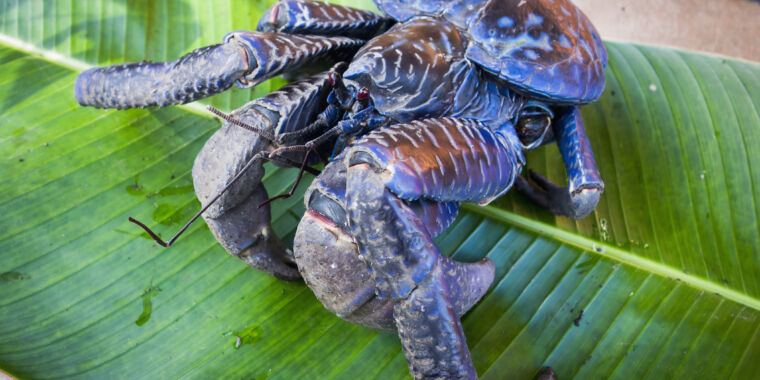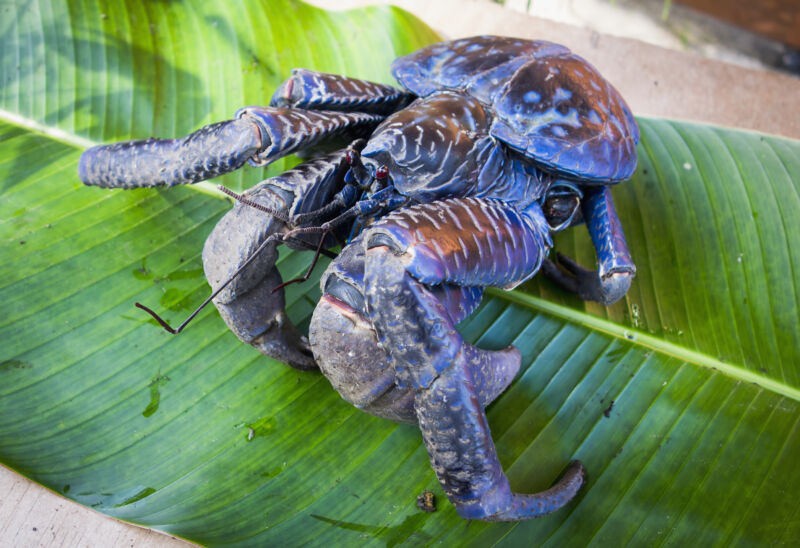

Many organisms on planet Earth aren’t crabs. Dogs, for instance—definitely not crabs. Science also suggests that humans are not, in fact, crabs. But a surprising number of creatures either are crabs or look a lot like them. For example, a hermit crab has a distinctly crab-like appearance but is not technically a real crab. Hermit crabs are not alone; over the history of life on Earth, there have been five separate cases in which decapod crustaceans have evolved this way, a process common enough that it has picked up a formal term: carcinization.
Around a year ago, this evolutionary process captured the imagination of the Internet. Headlines like “Why everything eventually becomes a crab” and “Why Does Evolution Keep Turning Everything Into Crabs” popped up. PBS even made a video.
“Everything” is clear hyperbole—the overwhelming majority of things on Earth are not crabs and seemingly have no plans to become them. But if there are benefits to having a crab-like shape on Earth, should we view that as a general rule of life? Could it hold true on other planets? If the process of carcinization operates here, it’s not unreasonable to expect that it might happen elsewhere.
Because we take these things far too seriously, Ars spoke to experts on crabs, evolution, and alien life to find out. The answer: it’s highly speculative, given that we haven’t found life—crab-like or otherwise—anywhere else, but it’s not wholly impossible.
OK, but why crabs?
The reasons creatures evolved crabby features are still unknown, though there are numerous hypotheses. According to Jo Wolfe, a researcher at Harvard University’s Department of Organismic and Evolutionary Biology, carcinization could be a mixture of genes and the environment. However, Wolfe—who penned a paper on the topic last March—also noted that there are still no definitive answers.
“There is no clear-cut reason why being a crab is better than not being a crab,” she told Ars.
Yet crab-like forms are common enough that a number of the things we call crabs aren’t all that closely related to crabs. For instance, a hermit crab is a decapod crustacean and part of a group called Anomura. Though they evolved to have crab-like features, they are not true crabs, which are in the infraorder Brachyura.
Wolfe said that the similar body plans may evolve because the body shape of a crab could have some advantages. Crab bodies tend to be compact and quite flat, with their abdomens folded up below. This could make them smaller targets for predators and could allow the crabs the ability to run and hide in smaller crevasses.
Claws might be a boon as well, Wolfe said. (Even though, again, having claws doesn’t make a species a crab—lobsters have huge claws but aren’t crabs.) But defending that argument is made harder by the fact that claws have multiple functions. Some crabs don’t even use their claws for predation; a male fiddler crab, for instance, uses his one massive claw for sexual display.
Wolfe also suggested that there are probably genetic limits to carcinization. The genetic makeup of a species that evolved a crab-like body plan would need to have the right building blocks for the process. So, for example, both shrimp and crabs have a genetic toolkit that lets them produce many limbs and exoskeletons, while humans do not—meaning, most likely, there are no human-relative crabs on the horizon.
When does being a crab make sense?
Right now, there’s no evidence that there is any life, much less crab life, on other planets. Even if we found aliens that looked like crabs, they obviously wouldn’t be crabs as we’ve defined them. With the right environment, however, crab-like aliens could hypothetically evolve elsewhere. Wolfe noted that any creatures on these theoretical planets would still need to have the right genetic building blocks to be capable of evolving into crab-like forms. And a converse is also true: planets different from Earth are less likely to have crabs.
For example, a planet like Naboo in Star Wars—which has land, bodies of water, rock, etc.—could be home to crabs, Wolfe said. On Earth, there are terrestrial crabs, which evolved from their marine kin. There are also terrestrial false crabs, such as the terrifying coconut crab. But largely, it seems that water or some kind of liquid on a planet would increase the odds of crabs being there.
If the form of a crab works because it makes it easier to scurry away into rocks and such, then some kind of rocky geography could also help a planet’s chances of carcinization. Going back to the Star Wars analogy, planets like the desert world Tatooine or the gas giant Bespin (home of Cloud City) probably wouldn’t have what it takes.
Crab-like creatures could also fill specific niches in planets with Earth-like environments, according to Arik Kershenbaum, a zoologist at the University of Cambridge and the author of 2020’s The Zoologist’s Guide to the Galaxy. Some crab species hang out at the bottom of the ocean and either eat the waste that flows down from higher in the water column or eat the other species that use the waste for nutrients.
Assuming another planet has aquatic life that dies and sinks to the bottom, that niche could also exist there. “You could see the sort of evolutionary game playing out very similarly to what presumably happened on Earth,” he told Ars.
This doesn’t necessarily mean that the niche would be filled by crab-like critters, however. There are some benefits that crabs do have, like claws, multiple legs to scuttle around on, and segmented bodies, Kershenbaum said. But he said that our guesses about the purposes of evolutionary traits aren’t always accurate. Further, he noted that in many cases, species simply inherit traits from previous generations, even after those traits no longer contribute to survival.
So they would be on Earth-like planets?
It seems likely that if there are space crabs, they’d probably come about on planets that have environments similar to Earth’s. For her part, Wolfe doesn’t necessarily expect that the emergence of life would need to be restricted to Earth-like planets. There could be all kinds of strange forms that evolve to live in alien environments. “I think that you could [have crab-like creatures on other planets]. I also think you could get things that don’t look like anything on Earth at all,” she said.
Kershenbaum doesn’t think that life in the stars needs to look exactly like life on Earth. Rather, weird and wacky alien life is just more likely to be rare by comparison. For example, there are plenty of rocky planets out there that probably have water on them, which could be a necessary precursor to life. But it’s possible that life could exist in settings that are distinctly different from Earth—like spores living in the acidic atmosphere of Venus.
“It seems likely that Earth-like planets are going to be relatively well-stocked with life compared to weird and wonderful planets,” he said. “More reasonable life is more likely to be common.”
Charles Marshall, director of the University of California Museum of Paleontology, said, however, that it’s a fairly narrow group of species that have evolved to become crabby on Earth. Moreover, these species are already pretty similar to crabs. “You’ve already got to be so close to being a crab before you evolve into a crab, it’s kind of a moot point,” he told Ars. “Life is produced in an enormous amount of morphologies, and crabbiness is just one of them.”
The presence of crabby creatures on a planet could suggest the planet has the potential to develop into something interesting, Marshall added. He said that if he were to send a probe into space to look for life, he’d expect to see many worm-shaped things—they’re quite common on Earth and have been around for more than 500 million years. For something to carcinize, there needs to be a vibrant ecology surrounding it. There would need to be predators for the organism to protect itself or hide from, plus a good variety of food. Worm-like forms probably don’t need all of that.
“Finding a crab might be indicative of a rich enough biosphere and a rich enough genomic potential that you may yet expect to evolve something like humans,” he said. “Therefore, searching for something like a crab might be a good idea. If [a planet hasn’t] evolved something crab-like, you know you’ve found a world that’s still relatively simple.”